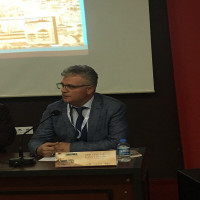Research Article
Issue Editorial Board
 0000-0001-9595-7398
0000-0001-9595-7398




Aim & Scope
The Journal of Vaqfs reveals the institution of waqf and cultural richness related to the institution of waqf, the cultural heritage formed by waqf, historical and current realities of waqfs in a scholarly manner, it is published in order to publicize the international level scientific studies related to the waqfs.
In the Journal of Vaqfs, the articles in the field of social sciences, dealing with waqf and historical and current problems of the waqf culture in a scholarly perspective and proposing solutions to this issue are included.
The manuscripts to be sent to the Waqfs Journal are required to be an original work filling a gap in its field or evaluating the previously published works, revealing new and remarkable views of research. The manuscripts, introducing documents, works and personalities related to waqf and the waqf culture, announcing new events are also published.
Author Guidelines
Language of Publication
The journal publishes in Turkish and English.
Style Guidelines
The following rules should be observed while preparing an article for submission to Journal of Vaqfs:
1. Title of the article: The title should suit the content and express it in the best way, and should be written in bold letters. The title should consist of no more than 10-12 words.
2. Name(s) and address(es) of the author(s): The name(s) and surname(s) of the author(s) should be written in bold characters, and addresses should be in normal font and italicized; the institution(s) the author(s) is/are affiliated with, their contact and e-mail addresses should also be specified.
3. Abstract: The article should include an abstract in Turkish at the beginning. The abstract should explain the topic clearly and concisely in a minimum of 75 and a maximum of 150 words. The abstract should not include references to sources, figures and charts. Keywords of 5 to 8 words should be placed at the end of the abstract. There should be a single space between the body of the abstract and the keywords. The keywords should be comprehensive and suitable to the content of the article. The English version of the title, abstract and keywords should be placed at the end of the article.
4. Body Text: The body of the article should be typed on A4 (29/7x21cm) paper on MS Word in Size 12 Times New Roman or a similar font using 1,5 line spacing. Margins of 2,5 cm should be left on all sides and the pages should be numbered. Articles should not exceed 10.000 words including the abstract and bibliography. Passages that need to be emphasized in the text should not be bold but italicized. Double emphases like using both italics and quotation marks should be avoided.
5. Section Titles: The article may contain main and sub-titles to enable a smoother flow of information. The main titles (main sections, bibliography and appedices) should be fully capitalized while the sub-titles should have only their first letters capitalized and should be written in bold characters.
6. Tables and Figures: Tables should have numbers and captions. In tables vertical lines should not be used. Horizontal lines should be used only to separate the subtitles within the table. The table number should be written at the top, fully aligned to the left, and should not be in italics. The caption should be written in italics, and the first letter of each word in the caption should be capitalized. Tables should be placed where they are most appropriate in the text. Figures should be prepared in line with black-and-white printing. The numbers and captions of the figures should be centered right below the figures. The figure numbers should be written in italics followed by a full-stop. The caption should immediately follow the number. The caption should not be written in italics, and the first letter of each word should be capitalized. Below is an example table.
.jpg)
7. Pictures: Pictures should be attached to the articles scanned in high-resolution print quality. The same rules for figures and tables apply in naming pictures.
The number of pages for figures, tables and pictures should not exceed 10 pages (one-third of the article). Authors having the necessary technical equipment and software may themselves insert their figures, drawings and pictures into the text provided these are ready for printing.
8. Quotations and Citations: Direct quotations should be placed in quotation marks. Quotations shorter than 2.5 lines should be placed within the flowing text. If the quotation is longer that 2.5 lines, it should be turned into a block quote with a 1.5 cm indentation on the right and left, and the font size should be 1 point smaller. Footnotes and endnotes should be avoided as much as possible. They should only be used for essential explanations and should be numbered automatically.
Citations within the text should be given in parentheses as follows:
(Köprülü, 1944: 15)
When sources with several authors are cited, the surname of the first author is given and ‘et. al’ is added.
(Gökay et al. 2002: 18)
If the text already includes the name of the author, only the date should be given:
In this respect, Tanpınar (1976: 131) says …
In sources and manuscripts with no publication date, only the surname of the author should be written; in encyclopedias and other sources without authors, only the name of the source should be written.
While quoting from a quotation, the original source should also be specified:
Köprülü (1926, qtd. in Çelik 1998).
Personal interviews should be cited within the text by giving the surnames and dates; they should also be cited in the bibliography. Internet references should always include date of access and be cited in the bibliography.
www.turkedebiyatiisimlersozlugu.com [Accessed: 15.12.2014]
9. References: References should be placed at the end of the text, the surnames of authors in alphabetical order. The work cited should be entered with the surname of the author placed at the beginning:
Example:
İsen, Mustafa (2010). Tezkireden Biyografiye. İstanbul: Kapı Yay.
Köprülü, Mehmet Fuat (1961). Azeri Edebiyatının Tekâmülü. İstanbul: MEB Yay.
If a source has two authors, the surname of the first author should be placed first; it is not functional to place the surname of the other authors first in alphabetical order.
Example:
Taner, Refika and Asım Bezirci (1981). Edebiyatımızda Seçme Hikâyeler. Başvuru Kitapları. İstanbul: Gözlem Yay.
If a source has more than three authors, the surname and name of the first author should be written, and the other authors should be indicated by et.al.
Example:
Akyüz, Kenan et.al. (1958). Fuzulî Türkçe Dîvân. Ankara: İş Bankası Yay.
The titles of books and journals should be italicized; article titles and book chapters should be placed in quotation marks. Page numbers need not be indicated for books. Shorter works like journals, encyclopedia entries and book chapters, however, require the indication of page numbers.
Example:
Berk, İlhan (1997). Poetika. İstanbul: Yapı Kredi Yay.
Demir, Nurettin (2012). “Türkçede Evidensiyel”. bilig, Türk Dünyası Sosyal Bilimler Dergisi 62: 97-117.
Translator’s, compiler’s and editor’s names (if there are any) should follow the author and title of the work:
Example:
Shaw, Stanford (1982). Osmanlı İmparatorluğu. Trans. Mehmet Harmancı. İstanbul: Sermet Matb.
If several references by the same author need to be cited, then the name and surname of the author need not be repeated for subsequent entries following the first entry. A long dash may be used instead. Several references by the same author should be listed according to the alphabetical order of work titles.
Example:
Develi, Hayati (2002). Evliya Çelebi Seyahatnamesine Göre 17. Yüzyıl Osmanlı Türkçesinde Ses Benzeşmesi ve Uyumlar. Ankara: TDK Yay.
_______ (2003). XVIII. Yüzyıl İstanbul Hayatına Dair Risâle-i Garîbe. İstanbul: Kitabevi.
If more than one work by the same author of the same date need to be cited, they should be indicated by (a, b).
Example:
Develi, Hayati (2002a). Evliya Çelebi Seyahatnamesine Göre 17. Yüzyıl Osmanlı Türkçesinde Ses Benzeşmesi ve Uyumlar. Ankara: TDK Yay.
Develi, Hayati (2002b). XVIII. Yüzyıl İstanbul Hayatına Dair Risâle-i Garîbe. İstanbul: Kitabevi
For encylopedia entries, if the author of the encylopedia entry is known, the author’s surname and name are written first. These are followed by the date of the entry, the title of the entry in quotation marks, the full name of the encyclopedia, its volume number, place of publication, publisher and page numbers:
Example:
İpekten, Haluk (1991). “Azmî-zâde Mustafa Hâletî”. İslâm Ansiklopedisi. C. 4. İstanbul: Türkiye Diyanet Vakfı Yay. 348-349.
For theses and dissertations, the following order should be followed: surname and name of the author, date, full title of thesis in italics, thesis type, city where the university is located, and the name of the university:
Example:
Karakaya, Burcu (2012). Garîbî’nin Yûsuf u Züleyhâ'sı: İnceleme-Tenkitli Metin-Dizin. Master’s Thesis. Kırşehir: Ahi Evran Üniversitesi.
Handwritten manuscripts should be cited in the following way: Author. Title of Work. Library. Collection. Catalogue number. sheet.
Example:
Âsım. Zeyl-i Zübdetü'l-Eş‘âr. Millet Kütüphanesi. A. Emirî Efendi. No. 1326. vr. 45a.
To cite a study found on the Internet, the following order should be followed: Author surname, Author name. “Title of message”. Internet address. (Date of Access)
Example:
Türkiye Cumhuriyet Merkez Bankası. ”Geçinme Endeksi (Ücretliler)” Elektronik Veri Dağıtım Sistemi. http://evds.tcmb.gov.tr/ (Accessed: 04.02.2009).
An article accepted for publication but not yet published can be cited in the following way:
Example:
Atılım, Murat ve Ekin Tokat (2008). ”Forecasting Oil Price Movements with Crack Spread Futures”. Energy Economics. In print (doi:10.1016/ j.eneco.2008.07.008).
Ethical Principles and Publication Policy
1- ETHİCAL PRINCIPLES
Journal of Vaqfs is published quarterly: June and December. At the end of each five year, an annual index is prepared and published in the December issue. Each issue is forwarded to subscribers, libraries and international indexing institutions within one month after its publication.
Academic review: Submissions found suitable are referred to two referees working in relevant fields. The names of the referees are kept confidential and referee reports are archived for five years. If one of the referee reports is positive and the other negative, the article may be forwarded to a third referee for further assessment or alternatively, the Editorial Board may make a final decision based on the nature of the two reports. The authors are responsible for revising their articles in line with the criticism and suggestions made by the referees and the Editorial Board. If they disagree with any issues, they may make an objection by providing clearly-stated reasons. Submissions which are not accepted for publication are not returned to their authors.
Legal responsibility: Authors have full responsibility for the views expressed in their articles and for their stylistic preferences. Quotations from other articles and duplication of photographs are permitted as long as they are fully referenced and cited.
Wage policy: The royalty rights of the articles accepted for publication are considered transferred to Directorate General of Foundations. The copyright fee is paid to the articles published in Journal of Waqfs.
Price Policy
The copyright of the articles accepted to be published in the Journal of Waqfs is deemed to have been transferred to the General Directorate of Foundations. The authors of the articles published in the journal are paid according to the provisions of the relevant regulation.
The articles sent to the Journal of Waqfs with a request for publication are subject to preliminary examination by the Editorial Board and at least two academicians who are experts in their fields are sent for review. The copyright of the articles accepted to be published in the Journal of Waqfs with the referee reports and the decision of the Editorial Board is deemed to have been transferred to the General Directorate of Foundations, and a royalty fee is paid to the published articles in accordance with the relevant legislation.

